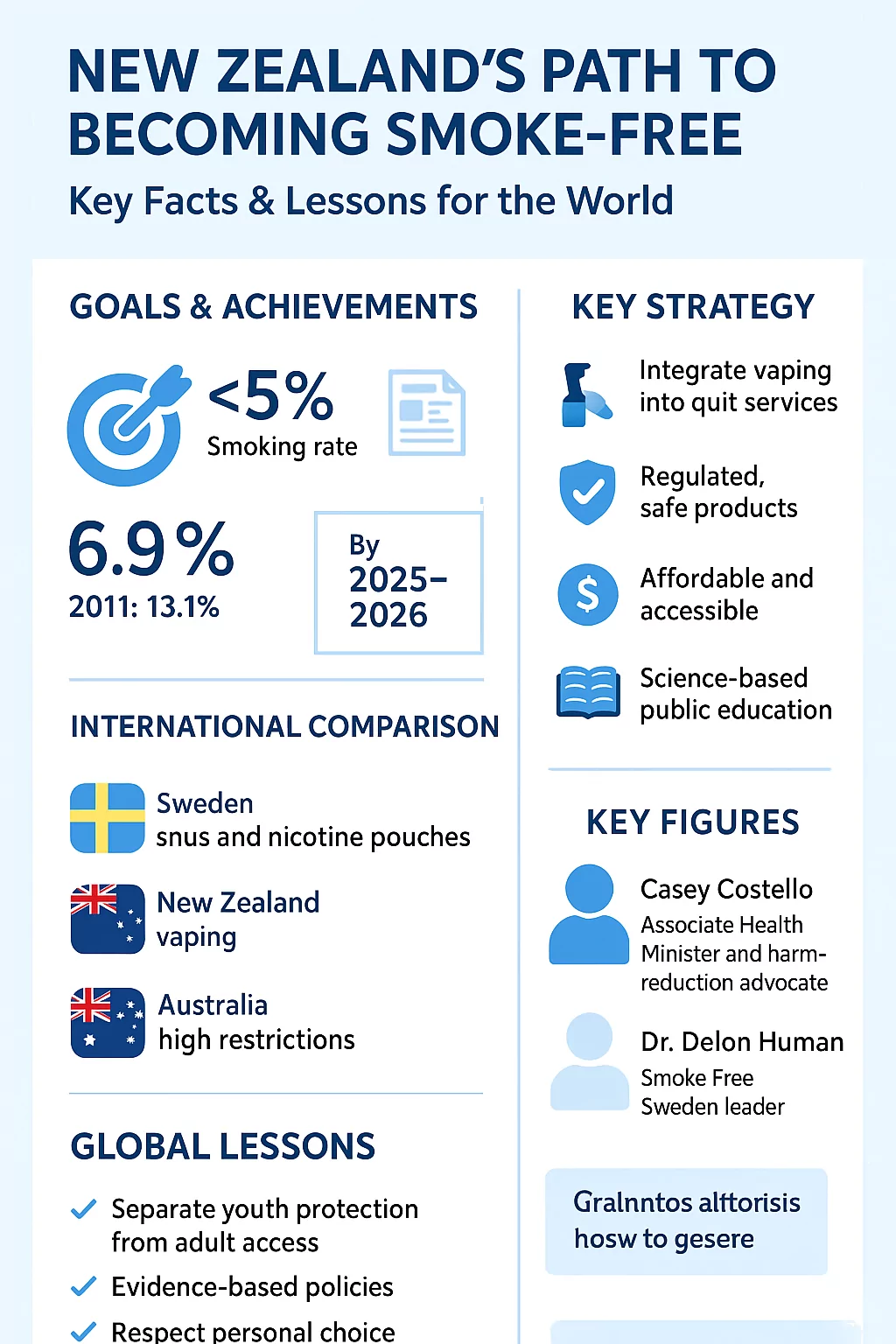New Zealand’s Smoke-Free Revolution: How Harm Reduction Is Beating Smoking Faster Than Prohibition Ever Could
While much of the world remains divided over bans, high taxes, and fear-driven anti-smoking campaigns, New Zealand is on track to become one of the first truly smoke-free nations. This remarkable shift hasn’t been driven by punitive crackdowns or moralizing slogans. Instead, it’s the result of science-led harm reduction, a pragmatic policy approach that treats smokers with respect, compassion, and real options for change.
At the forefront of this transformation is Associate Health Minister Casey Costello, a vocal advocate for safer nicotine alternatives. Her message to Parliament earlier this year was simple yet radical: you don’t end smoking by outlawing tobacco overnight — you end it by offering people safer, appealing, and accessible alternatives.
The Results: Smoking Rates Halved in Just Over a Decade
In 2011, 13.1% of New Zealand adults smoked daily. By 2024, that figure had plummeted to 6.9% — one of the steepest declines in the world.
This wasn’t an accident. New Zealand’s success came from deliberately integrating harm-reduction tools like vaping into its public health framework. Instead of treating vaping as a threat, policymakers positioned it as a legitimate and regulated cessation tool, available through stop-smoking services and retail channels for adults.
The outcome? Smokers switched to lower-risk products in record numbers. In just over a decade, New Zealand moved closer to the WHO’s “smoke-free” threshold (less than 5% daily smoking) than many nations have in generations.
From Fear Campaigns to Practical Support
Costello has publicly challenged what she calls “scaremongering” over vaping — a trend seen in many countries where health officials conflate youth vaping prevention with adult harm reduction. Her approach focuses on real-world outcomes rather than political optics.
This shift mirrors the Smoke Free Sweden model, which reduced smoking rates to the lowest in Europe through legal, regulated access to low-risk nicotine products like snus and nicotine pouches. Sweden’s success proved that when smokers are given attractive, affordable alternatives, combustible cigarette use collapses. New Zealand adapted this principle for the modern era, using vaping as its primary switch tool.
Why Harm Reduction Works When Abstinence-Only Fails
Public health history shows that an abstinence-only approach — telling smokers to “just quit” without offering alternatives — leaves the most addicted behind. New Zealand’s harm-reduction strategy acknowledges that some smokers may never quit nicotine entirely, but they can dramatically reduce their health risks by switching to less harmful forms.
This pragmatism stands in stark contrast to countries like Australia, where tight vaping restrictions and high cigarette taxes have kept smoking rates falling far more slowly. In fact, critics warn that overly restrictive vaping laws risk pushing former smokers back to cigarettes — undoing years of progress.
Global Recognition and Praise
International public health leaders have taken notice. Dr. Delon Human, head of the Smoke Free Sweden initiative and former Secretary-General of the World Medical Association, praised New Zealand’s “evidence-based courage” in the face of prohibitionist pressure.
Similarly, Professor Robert Beaglehole, a respected New Zealand public health figure, has called the country a “global leader” in smoking reduction. He credits the willingness to embed vaping within cessation services, rather than excluding it, as a key factor in the rapid decline.
Overcoming Opposition with Data
Costello’s journey hasn’t been without resistance. Anti-vaping advocacy groups have pushed for flavor bans, tax hikes, and severe restrictions — measures she argues would punish adults trying to quit smoking. Her response has been consistent: protect young people from nicotine initiation, but do not block access for adult smokers seeking safer options.
By separating youth-protection policy from adult harm-reduction policy, New Zealand has avoided the policy traps that stall progress elsewhere. Regulations focus on product safety, quality control, and responsible marketing, while keeping the harm-reduction pathway open.

Lessons for the World
New Zealand’s success offers three clear lessons for any country aiming to go smoke-free:
- Embrace Regulated Harm Reduction – Provide legal, quality-controlled alternatives that are accessible and affordable to adult smokers.
- Prioritize Outcomes Over Optics – Judge policies by their ability to reduce smoking rates, not by how politically “tough” they appear.
- Protect Youth Without Penalizing Adults – Balance youth prevention with continued access for smokers who want to switch.
For Australia and others still debating the role of vaping, the evidence from New Zealand and Sweden is now impossible to ignore.
A Roadmap for Rapid Change
If replicated globally, New Zealand’s approach could slash smoking-related disease within a single generation. That means millions fewer cases of cancer, heart disease, and respiratory illness — and billions saved in healthcare costs.
This is not just a policy win; it’s a public health revolution in progress. It shows that when science, compassion, and political courage align, the seemingly impossible — a smoke-free nation — can become reality in years, not decades.
- Read the original content here: New Zealand’s Smoke-Free Revolution: Harm Reduction, Not Prohibition, Is Winning the Fight Against Smoking








